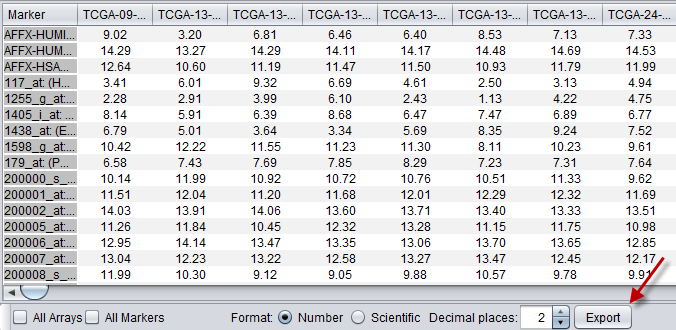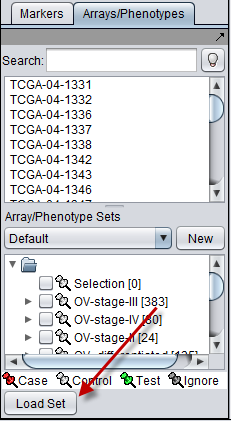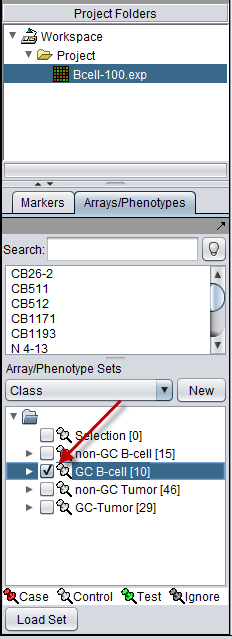Download and Installation
|
Download Instructions | License Information |
This section contains instructions for downloading and installing geWorkbench.
Contents
- 1 geWorkbench 2.2.2 update components
- 2 geWorkbench 2.2.2 - System Requirements
- 3 IMPORTANT NOTICE ABOUT THE LICENSE
- 4 Downloads
- 5 Installation Instructions
- 6 Java Environment Configuration
- 7 Typical steps in running X-windows
- 8 Quick Start
- 9 Community Support Forums
- 10 Tutorial data
- 11 Training Slides
geWorkbench 2.2.2 update components
Overview of updated components
Two geWorkbench v2.2.2 components have been updated to add very useful new functionality. These drop-in updated components are being supplied ahead of the next geWorkbench release. The two components are "microarrays" and "selectors".
- Microarrays - this is the Tabular Microarray Viewer. The new feature added is an export button. Only arrays and markers that are visible in the Viewer will be exported. This is controlled using the array and marker selection components. These components provide the ability to define and "activate" sets of arrays or markers. If any set is active, only the arrays or markers in the active set or sets will be displayed in the Tabular Viewer.
- Selectors - This updates the Arrays/Phenotypes component to add the ability to load sets of arrays from CSV format files, one array per line.
Loading one or both of the new components involves three steps.
- Move or remove the original component(s).
- Download the new component or components.
- Copy in the updated component.
Step-by-step instructions
To replace the existing components with the new ones, you will need to locate the geWorkbench installation folder on your machine. The regular geWorkbench installation directions below provide a guide as to where this installation folder is located. Within that folder is another called "components". Go into this directory.
- In the components directory, remove the component you want to replace (microarrays, selectors, or both). You can delete it, or, better, cut it, and then paste it into another folder not part of the geWorkbench installation (e.g. in your home directory). This way, if something goes wrong, you can put the original component back in place.
- Download and unzip the new components: Microarrays.zip, Selectors.zip
- Copy the new component(s) into the geWorkbench "components" directory.
Start geWorkbench. The new features should be in place.
The new "export" button in the Tabular Microarray Viewer:
Images of the new components
The new "Load Set" button in the Arrays component:
Example of exporting a subset of array data
This example uses the tutorial data file Bcell-100.zip (5.256 MB) .
1. Load BCell-100.exp. See the tutorial chapter on loading local data files. You do not need to load an annotation file for this example.
2. Go to the Arrays/Phenotypes selector control. Choose the array list named "class" (see figure).
3. Activate one of the array sets by checking the box next to its entry. In the figure, we have activated the GC B-cell class, which has 10 arrays.
4. Note that in the Tabular Microarray Viewer component, only the set of 10 arrays is displayed.
5. Press the "Export" button. You will be prompted to save the array data to a new, tab-delimited file.
geWorkbench 2.2.2 - System Requirements
Java
- The Java 6 Runtime Environment (JRE6) is required.
- For Windows and Linux, geWorkbench is distributed in two installer forms, one with and one without the JRE6 included. To install a version of geWorkbench that does not include the JRE, the JRE must be installed separately on the machine.
- On MacOSX, the Java 6 JRE is included with MacOSX versions 10.5 and higher with the latest updates (Intel platforms only). Java 6 is not available for the PowerPC platform.
- The "Generic" distribution of geWorkbench does not include the JRE6. It must be installed separately.
- geWorkbench can run on both 32-bit and 64-bit versions of Java on appropriate OS platforms.
- There are known incompatibilities with Java 7.
How to choose
- Using an installer version of geWorkbench that inludes the JRE6 allows you to be sure that you are running geWorkbench with the correct version of the JRE. For example, some systems may also have older versions of Java installed.
- You may wish to install a "no JRE" version of geWorkbench if you want to choose between 32 and 64 bit JREs, or to keep up with the latest updates to the JRE.
Obtaining the Java 6 JRE
- The JRE6 can be downloaded from http://java.sun.com/javase/downloads/index.jsp.
- Note: Java 6 is, in places, referred to by Sun as Java 1.6.
Display Driver
- This requirement pertains only to using the PCA component 3D graph viewer.
- When using a 64-bit JVM, the Java 3D library requires OpenGL version 1.2 or higher to be supported by your display driver.
Memory
At least 2 GB is recommended. geWorkbench 2.2.2 by default will request up to 1 GB of memory for the Java VM.
Operating System
- Windows XP/Vista/Windows 7 (32 or 64-bit): no special requirements.
- MacOSX: Version 10.5 or higher with latest updates is required to provide the Java 6 JRE (Intel platform only).
- Linux: no special requirements known.
geWorkbench, unless otherwise noted for particular components, can be run on both 32 and 64-bit operating systems and JREs.
Graphics Driver
At least one component, the PCA viewer, uses a Java 3D library. When using a 64-bit JVM, the Java 3D library requires OpenGL version 1.2 or higher to be supported by the graphics display adapter in your computer.
IMPORTANT NOTICE ABOUT THE LICENSE
Use of geWorkbench is governed by the rules specified in the software license. Please make sure to read the license and understand your obligations before proceeding to download the application.
Downloads
Up-to-date versions of geWorkbench and the geWorkbench Software Development Kit can be downloaded from the project page at NCI's GForge repository: http://gforge.nci.nih.gov/frs/?group_id=78
Installation Instructions
All three platform-specific versions of geWorkbench (Windows, Linux, and Macintosh) provide an installation wizard (generated using InstallAnywhere).
- Using an installer version of geWorkbench that inludes the JRE6 allows you to be sure that you are running geWorkbench with the correct version of the JRE. For example, some systems may also have older versions of Java installed.
- You may wish to install a "no JRE" version of geWorkbench if you want to choose yourself between 32 and 64 bit JREs, or to keep up with the latest updates to the JRE.
- On Windows and Linux, geWorkbench was tested using installer versions which included the JRE6. The included JREs are 32-bit versions.
A generic version of geWorkbench, which does not use any installer, is also available.
Windows (XP/Vista/Windows 7)
Special note for Vista/Windows 7
If you run the installer on Vista or Windows 7, please install geWorkbench to your user home directory, e.g. C:\Users\username\geWorkbench_2.2.2, where username is your Windows login name, rather than to C:\Program Files\geWorkbench_2.2.2.
Installer with JRE6
- File: geWorkbench_v2.2.2_Windows_installer_with_JRE6.exe
- Includes the 32-bit Sun Java 6 JRE.
Download and double-click the installer file to begin installation.
Installer without JRE6
- File: geWorkbench_v2.2.2_Windows_installer_noJRE.exe
- No JRE is included, you must make sure that an appropriate Java 6 JRE is installed on your system before installing geWorkbench.
Download and double-click the installer file to begin installation.
MacOSX
- File: geWorkbench_v2.2.2_MacOSX_installer.zip.
- This version relies on the Java 6 JRE included with recent updates to the MacOSX 10.5+ operating system (Intel platforms only).
Double-click geWorkbench_v2.2.2_MacOSX_installer.zip to begin installation.
Notes
- Requires Mac OS X 10.5 or later with recent updates.
- As Java 6 is not available for the PowerPC platform, regardless of OS X version, geworkbench will not run on the PowerPC platform under any version of OS X.
- The compressed installer should be expanded automatically by the system.
Linux
Installer with JRE6
- File: geWorkbench_v2.2.2_Linux_installer_with_JRE6.bin.
- Includes the 32-bit Sun Java 6 JRE.
Installer without JRE6
- File: geWorkbench_v2.2.2_Linux_installer_noJRE.bin.
- No JRE is included, you must make sure that an appropriate Java 6 JRE is installed on your system before installing geWorkbench.
- You may need to configure the JRE. See section below, "Java Environment Configuration".
Installation
The Linux version of geWorkbench relies on X-Windows being installed and running. If you are running Linux on a server and e.g. you wish to view the application on a Windows desktop, you will also need to run an X-windows server on your desktop machine. See X-Windows configuration instructions below.
After downloading, cd (if needed) to the directory to which you downloaded the installer.
To begin the installation, type the command for the particular version, e.g. for the installer with JRE:
"sh ./geWorkbench_v2.2.2_Linux_installer_with_JRE6.bin".
This will extract geWorkbench into a new directory called geWorkbench_2.2.2.
Running geWorkbench (Linux)
To run geWorkbench, and assuming you are using the Linux bash shell, issue the command:
"./rungeWorkbench_2.2.2"
Generic
A non-installer-based version of geWorkbench is supplied in a Zip file which should work on any platform.
File: geWorkbench_v2.2.2_Generic.zip
Installation
Unzip the file. It will create a directory geWorkbench_2.2.2.
Running geWorkbench (generic)
You must have the Java 6 JRE installed and the JRE must be in the path for geWorkbench (see Java Environment Configuration below).
Windows: you can double click on the file "launch_geWorkbench.bat" to launch geWorkbench, or run it from a command window.
Linux/Unix: Execute the script "launch_geworkbench.sh".
Any: Alternatively, if you have Apache Ant installed, you can type "ant run" in the geWorkbench directory.
Java Environment Configuration
To run a version of geWorkbench that does not include the Java 6 Runtime Environment (JRE6), the JRE6 must be installed and, depending on the platform configured separately.
Two environment variables may need to be properly configured. These are the JAVA_HOME and the PATH variables. They should be configured to point to your own installation of the JRE6.
Here is an example of setting the two environment variables for a JRE installed in the directory /opt:
JAVA_HOME=/opt/jre1.6.0_26
PATH=/opt/jre1.6.0_26/bin:$PATH
Typical steps in running X-windows
Here are some typical steps to configure a remote Linux host and a local desktop X-server. Under Windows, a local X-server can be provided for example by the Cygwin package.
On the remote Linux host (assuming you are using the bash shell), issue the command
- "export DISPLAY=(your IP):0"
where (your IP) should be substituted with the IP address of your local desktop machine.
On your local desktop machine, you may need to
- start the X-windows server with a command such as "startx". You may need to cd to the X11 bin directory to find this command.
- allow remote connections with a command such as "xhost +".
Quick Start
A Quick Start guide to geWorkbench is being developed.
Community Support Forums
geWorkbench community forums are operated by the caBIG Molecular Analysis Tools Knowledge Center. There are separate user and developer forums. Anyone can browse through existing postings, but to start a new topic one must first register.
The forums can be viewed at https://cabig-kc.nci.nih.gov/Molecular/forums/
Tutorial data
tutorial_data.zip (3.586 MB) - data files in several different formats useful for the tutorials or just trying out geWorkbench.
Bcell-100.zip (5.256 MB) - A large (100 array) microarray dataset in the geWorkbench matrix format. Data is from the lab of Riccardo Dalla-Favera, Columbia University, and is provided only for use in learning and testing geWorkbench. It was obtained from experiments using Affymetrix HG-U95Av2 chips. This file contains the same data as the previously used file "webmatrix", but with the array subsets given more descriptive names.
Training Slides
A set of PowerPoint training slides for an earlier version of geWorkbench is still available. The PowerPoint file is available from the Project Documentation section of this site.




